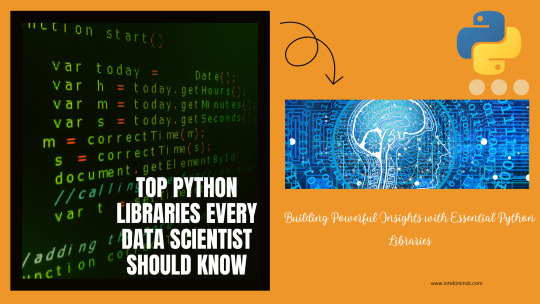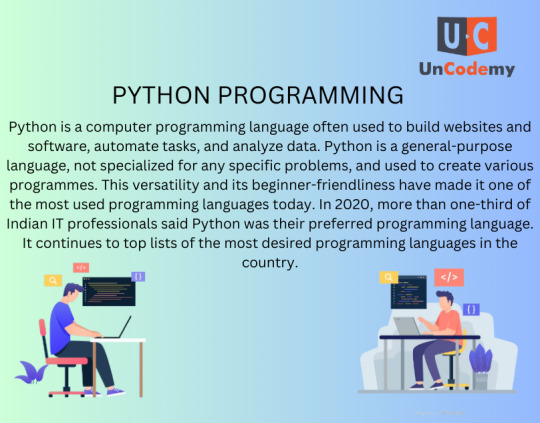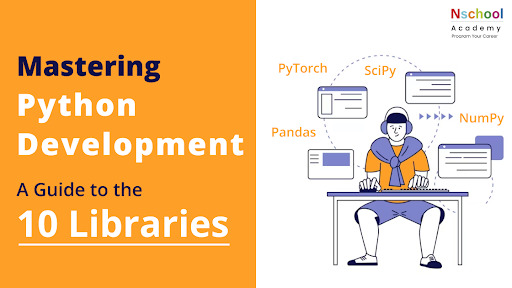#python libraries
Explore tagged Tumblr posts
Text
The Growing Importance of Data Science in the Digital Age Data science has emerged as a transformative field, fueling industries across the globe with actionable insights. In today’s data-driven world, organizations are leveraging data to make informed decisions, predict trends, and uncover hidden patterns.
2 notes
·
View notes
Text
#nlp libraries#natural language processing libraries#python libraries#nodejs nlp libraries#python and libraries#javascript nlp libraries#best nlp libraries for nodejs#nlp libraries for java script#best nlp libraries for javascript#nlp libraries for nodejs and javascript#nltk library#python library#pattern library#python best gui library#python library re#python library requests#python library list#python library pandas#python best plotting library
0 notes
Text
What is Python? Trusted Choice of AI, Web Development, Further Solutions
Python has revolutionized the modern world in the way that it gave the technologically skilled an influential language to develop with. It has application across different domains including web development, data analyzing, artificial intelligence and automation among others. Python’s characteristics of providing efficient solution to complicated problems while one can build applications possessing high performance make the language valuable and widely used in the world of technology. It is one of the simplest languages to learn and understand, coupled with its syntactically clean form, jQuery proves to be useful among novice as well as expert programmers. Besides, Python has remained very flexible to fit the changing technology needs, making it a most staple in such industries like finance, health, education, and entertainment.
0 notes
Text
Top Python Libraries Every Data Scientist Should Know
overview of essential Python libraries for data science:
NumPy: Provides support for large, multi-dimensional arrays and matrices, along with a collection of mathematical functions for numerical operations.
Pandas: Offers data structures like DataFrames for efficient data manipulation, cleaning, and analysis.
Matplotlib: A plotting library for creating static, interactive, and animated visualizations in Python.
Seaborn: Built on Matplotlib, it provides a high-level interface for drawing attractive and informative statistical graphics.
SciPy: Extends NumPy with additional modules for optimization, integration, interpolation, eigenvalue problems, and other advanced mathematical functions.
Scikit-Learn: A library for machine learning that includes tools for data mining, data analysis, and building predictive models.
TensorFlow: An open-source library for machine learning and deep learning, offering a flexible ecosystem for building and deploying models.
Keras: A high-level API for building and training neural networks, often used with TensorFlow for deep learning applications.
Statsmodels: Provides classes and functions for estimating and interpreting statistical models and conducting hypothesis tests.
Plotly: Enables the creation of interactive, web-based visualizations and dashboards, supporting a wide range of chart types.

0 notes
Text
Getting Started with Python: A Beginner's Guide pt3
In the first two parts of our beginner’s guide to Python, we covered variables, data types, conditional statements, collections, loops, and functions. In this final part, we will delve into more advanced concepts such as libraries, classes, and objects, which will further enhance your Python programming skills. Libraries: Extending Python’s Capabilities Libraries are collections of pre-written…
#Getting started with Python#Introduction to Python programming#Learn Python#Object-Oriented Programming#OOP in Python#Python basics#Python classes#Python for beginners#Python libraries#Python objects
0 notes
Text

Discover the world of statistical analysis with Python! Discover how libraries like NumPy, SciPy, Pandas, and Statsmodels make crunching numbers and extracting insights a breeze. Elevate your data science game today. https://t.ly/z0iWs
0 notes
Text
Top Python Libraries for Machine Learning in 2024
Introduction:
In the fast-evolving landscape of machine learning, Python continues to dominate as the go-to language for developers. With an extensive array of libraries, Python facilitates the development of powerful and efficient machine learning models. In 2024, the demand for custom Python web applications with integrated machine learning capabilities is on the rise, making it essential for businesses to hire dedicated Python developers proficient in the latest libraries. Let's explore some key Python libraries for machine learning and their role in custom web applications development.

TensorFlow 2.x:
TensorFlow has consistently been at the forefront of machine learning libraries, and in 2024, version 2.x has solidified its position. TensorFlow 2.x simplifies model building and deployment, making it ideal for custom Python web applications. Dedicated Python developers can leverage TensorFlow's capabilities for tasks such as image recognition, natural language processing, and more.
PyTorch:
PyTorch's dynamic computational graph and flexibility have made it a favorite among researchers and developers alike. With an extensive community and support, PyTorch is well-suited for building custom machine learning models, especially in scenarios where rapid prototyping is crucial. Dedicated Python developers can harness PyTorch for seamless integration into web applications, offering advanced functionalities.
Scikit-Learn:
As a versatile machine learning library, Scikit-Learn provides a wide range of tools for data preprocessing, model selection, and evaluation. It simplifies the implementation of machine learning algorithms, making it an essential tool for developers working on custom Python web applications with predictive analytics features.
FastAPI:
FastAPI has gained popularity for its speed and simplicity in building APIs. With the rise of machine learning-powered applications, FastAPI becomes crucial for creating robust and efficient backend systems. Dedicated Python developers can utilize FastAPI to seamlessly integrate machine learning models into custom web applications, ensuring high performance and responsiveness.
XGBoost and LightGBM:
For those focusing on boosting algorithms, XGBoost and LightGBM continue to be top choices. These libraries excel in handling tabular data and are widely used for tasks like regression and classification. Dedicated Python developers can leverage these libraries to enhance the predictive capabilities of custom web applications.
FAQs:
Q1: Why should businesses hire dedicated Python developers for custom web applications development with machine learning?
A1: Dedicated Python developers bring specialized expertise in utilizing machine learning libraries to tailor web applications according to business needs. Their proficiency ensures seamless integration of machine learning models, enhancing the application's functionality.
Q2: How can TensorFlow 2.x benefit custom web applications in 2024?
A2: TensorFlow 2.x simplifies the development and deployment of machine learning models, making it an ideal choice for custom web applications. Its capabilities enable developers to implement advanced features like image recognition and natural language processing with ease.
Q3: What role does FastAPI play in building machine learning-powered custom web applications?
A3: FastAPI's speed and simplicity make it an excellent choice for building APIs in machine learning applications. Dedicated Python developers can leverage FastAPI to create efficient backend systems, ensuring seamless integration of machine learning models into custom web applications.
In conclusion, staying abreast of the latest Python libraries for machine learning is essential for businesses aiming to develop custom web applications with advanced capabilities. Hiring dedicated Python developers ensures that these libraries are effectively utilized to create robust and efficient solutions tailored to specific business requirements.
0 notes
Text
Top Python Libraries For Artificial Intelligence
Quick summary: There are many numbers of libraries and tools available for developers in the growth of Python but in this blog, I will suggest to you the best Python AI Library which you will be going to use in your next project for the successful completion of your project. So, If you searching for the best Python AI library you are on the right blog.
Introduction
Python one of the most used programming languages in AI development application due to its accessibility and simplicity, as well as Python, is easy to understand to nontechnical background people. Moreover, Python is a vast eco-system, there are external libraries like a plethora that make the task simpler.
In Addition, The developer used the Python AI library for complex tasks like they don’t need to write code twice. The reason for the growing popularity of AI libraries because the best combination of consistent syntax, flexibility, and time saving of developers.
In this blog, we are going to discuss the top-quality of the Python AI library, Pros and Cons of the Python AI library so, let’s dive and explore the Python Artificial Intelligence library.
Scikit-learn
One of the well-known python AI library that accent unsupervised and supervised algorithms. Scikit-learn built on two basic python library Scipy and NumPy. The Scikit-learn library mainly used for analysis and data mining as well as helps in preprocessing, dimensionality reduction, and model selection.
For
computational graph abstraction. TensorBoard for visualization.
Against
Not best for Building Models Not effective With GPU
TensorFlow
TensorFlow developed by the Google team. Released in November 2015 the specialty is that runs on many platforms like CPUs, GPUs, TPUs as well as it is an open-source, Free software library. Moreover, it supports toolkits for developing models with different levels of abstraction.
For
computational graph abstraction. TensorBoard for visualization.
Against
Sometimes works slow A shortfall of Pre-trained models
Theano
Theano is the competitor of TensorFlow but Theno is a robust python library that provides numerical operation with multi-dimensional arrays in high-level efficiency. Theano library uses the GPU for carrying out data-intensive computations moreover, in 2017 the development in Theano come up with a new cease. The library is most used in evaluating a mathematical expression, matrix calculation, data-intensive computation which is 140x faster.
For
Best optimized for CPU and GPU Effective in numerical computation
Against
Bug issue in AWS. High level of abstraction possible by using other libraries with it
Keras
Keras neural network open-source library is written in Python because of neural network it is extensible, modular, user-friendly, and best for beginners. It also works with building blocks in neural networks of layer, objectives, optimizer, and activation functions. It allows fast prototyping as well as run on GPU and CPU
For
Extensible Run-on GPU and CPU Work in Theano and Tensor Flow
Against
Not efficient in the independent framework An issue in Image Recognition
PyTorch
PyTorch is created by Facebook as the AI system is built on the tensor computation with GPU acceleration. PyTorch easily integrates with data science stacks that help in computations on tensors.
For
Effective utilized with Other Libraries Robust Ecosystem
Against
Maximize build efficiency Empower developers
XGBoost
XGBoost is the Python AI library also known as extreme gradient boosting that use to classify data also built decision-tree algorithms. This model trained with new weaker regression models fills the gaps so no other improvement can be made due to this XGBoost built performance and scalability.
For
Scalable Accurate boosted trees algorithms
Against
Categorical Variables into One Hot Encoding
Final Words
The above Python AI library is discussed in this article is high quality and very efficient that many big giants companies are using it, for instance, Google, Yahoo, Apple, Facebook. Some of the libraries are similar in machine learning because they have capabilities to meet the requirements in AI and ML projects In addition to this Python Libary for Machine Learning is also similar you can choose from them also.
You can also choose other libraries which meet your project requirements but the above-listed library is the most used and popular in the Artificial Intelligence project. In Addition, Microsoft also uses this library in their AI and ML projects so, what are you waiting for? You can also reduce your workload by the offshore dedicated developer or hire Python developer this also the best decision eve
0 notes
Text
Explore the transformative potential of data visualization with a focused exploration of Matplotlib and Seaborn in Python. Unleash the power of these libraries to create compelling and insightful visual representations, unlocking deeper insights from your data. Read more...
0 notes
Text
In simple terms, a Python library is a collection of pre-written code designed to perform common tasks. Think of libraries as toolboxes containing specific functions and modules that allow you to do more with less effort. Rather than crafting every segment of code manually, you can leverage these libraries to streamline your workflow, conserving time while enhancing efficiency. Libraries are a great way to learn best practices, as they provide solutions to many common challenges in programming.
0 notes
Text
5 Essential Python-Beginner Libraries You Should Know
As a Python beginner, you see videos and tutorials on YouTube or maybe read a blog, just like right now. In such tutorial videos/blogs, you come across many Python libraries that may or may not be popular. For instance, you might have heard of Numpy library which is great for mathematical operations. However, relatively few of you might have heard of Pandas, which is a library meant for data…

View On WordPress
0 notes
Text
How to Instantiate a Class in Python? Here's how:
0 notes
Text
Harnessing Linux for Data Science: Integrating R, Python, and Machine Learning
Linux is the most appropriate OS for data research since it is portable, expansible and complies with many different open-source software. In this respect, machine learning frameworks can be easily linked to the powerful computation languages such as R and Python in Linux to let data scientists fully optimise the resourceful processing efficiency and model construction. It is now time to consider how these technologies improve the productivity of data science processes. They offer a less rigorous process when clients begin to employ Linux as their foundation, coupling the utility of Python with the statistician might of R. They also improve the understanding, in the process of raising production.
0 notes
Text

PYTHON’S ROLE IN THE FUTURE OF AI AND MACHINE LEARNING
Welcome to the world of artificial intelligence (AI) and machine learning (ML), where innovation knows no bounds. In this fast-evolving technological landscape, Python stands as a pivotal player, driving the engines of progress and transformation. Let’s embark on a journey to unravel the profound role Python plays in shaping the future of AI and ML. Picture a realm where machines can comprehend human language, identify images with astonishing accuracy, and even predict future events with uncanny precision. This is the magic of AI and ML, and Python is the magician’s wand that makes it all possible for more details: https://bdnews55.com/2023/09/21/pythons-role-in-the-future-of-ai-and-machine-learning/
1 note
·
View note
Text

Understand Python has become one of the most popular programming languages in the world due to its ease of use, readability, and a vast ecosystem of libraries.
For more details : https://www.n-school.com/performance-testing-optimizing-software-blog/
0 notes
